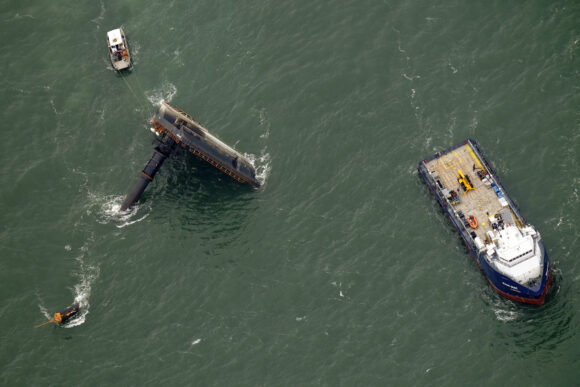NEW ORLEANS (AP) — The offshore service vessel that capsized in the Gulf of Mexico in a deadly April disaster is cracking and will have to be brought ashore in sections, the U.S. Coast Guard said Wednesday.
A Coast Guard news release said the Seacor Power had rotated in the spot where it partially sank after capsizing April 13 off Louisiana’s coast. Salvage workers reported signs of cracking and separation of the hull from the superstructure, indicating the vessel’s structural integrity has been compromised, according to the release.
A “lift boat” equipped with legs, the vessel can be lowered to the sea floor to anchor it in place for work on nearby oil and gas facilities. It overturned as it was heading to a job site with 19 people aboard. Only six survived.
Six bodies were recovered from the wreckage or Gulf waters. Seven people are missing and presumed dead.
Family members were briefed on salvage efforts Wednesday by officials with the company that owns the vessel and by the salvage company, Donjon-SMIT.
The Coast Guard said efforts so far have involved removal of debris around the vessel to make room for salvage equipment. Salvage efforts will include the use of a submersible barge that can be maneuvered under larger sections of the vessel, then refloated. The Coast Guard says the largest sections could be removed by the end of June, but that could be delayed by weather or other factors.
More lawsuits were filed Tuesday in connection with the capsizing, providing harrowing descriptions of what survivors endured in the accident that killed 13 shipmates.
Bryan Mires and James Gracien are among the six who survived after the Seacor Power overturned in severe weather on April 13. The widow of a man who died also filed suit Tuesday in New Orleans.
“After being slammed into an interior vessel wall while the vessel took on water and breaking a window with a fire extinguisher, Plaintiff James Gracien escaped from his living quarters aboard the capsized vessel,” and then drifted in cold waters for three hours, suffering hypothermia, before he was rescued, his lawsuit says.
Mires’ lawsuit says he used a pocketknife to free himself from ropes that had tangled around his legs after the vessel capsized. It said he was washed into rough, frigid Gulf waters and drifted for about two hours before he was rescued.
Hannah Daspit, the widow of Dylan Daspit, had earlier filed a lawsuit in state court in Houston, Texas, where at least four other related lawsuits are pending.
With Tuesday’s filings, at least nine civil suits are pending in federal courts. A federal judge began issuing orders Monday putting the cases on hold pending action on an effort by the Seacor Power’s owners to limit their liability in the state and federal cases under federal maritime law.
The Seacor Power was a “liftboat” vessel with three legs that can be lowered to the sea floor, converting the ship to an offshore platform that can service oil and gas facilities. It had been chartered by Talos Energy LLC for work on a Gulf platform and capsized on its way there.
Defendants in the latest lawsuits are Talos and two affiliated companies described as owners and operators of the vessel, Seacor Marine LLC and Falcon Global Offshore II LLC.
Was this article valuable?
Here are more articles you may enjoy.


 California Governor Seeks $200M to Replace EV Tax Credits Cut by Trump
California Governor Seeks $200M to Replace EV Tax Credits Cut by Trump  California Bill Would Require Insurer Claims Handling Plans, And Double Penalties
California Bill Would Require Insurer Claims Handling Plans, And Double Penalties  Musk’s xAI Faces California AG Probe Over Grok Sexual Images
Musk’s xAI Faces California AG Probe Over Grok Sexual Images  Allianz Built An AI Agent to Train Claims Professionals in Virtual Reality
Allianz Built An AI Agent to Train Claims Professionals in Virtual Reality 